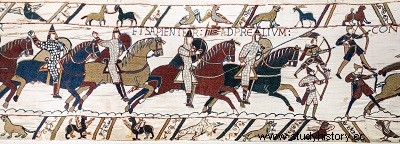
The Battle of Hastings took place on October 14, 1066 about ten kilometers north of the town of Hastings, in East Sussex. It opposes the last Anglo-Saxon king of England, Harold Godwinson, to Duke William of Normandy, and ends in a decisive victory for the latter.
Hastings is part of the succession crisis opened by the death of King Edward the Confessor in January 1066. Elected and crowned successor of Edward, Harold must face the invasions launched by claimants to the crown. He defeated Norway's King Harald Hardrada on September 25 at Stamford Bridge, Yorkshire, but meanwhile Duke William of Normandy landed in Sussex, on the other side of the country. Harold rushes to meet him on a forced march.
The battle lasts from the morning until the evening of October 14. Posted at the top of the hill of Caldbec, the English troops resist the first enemy attacks. The Normans then resorted to a ruse:they pretended to flee before turning on the English in pursuit. The English army finally gave in and broke up after Harold's death, and the victory went to William.
Thanks to his victory, the Duke of Normandy can walk to London, and he is crowned King of England on Christmas Day in Westminster. The Norman conquest of England was not truly completed until several years later.
